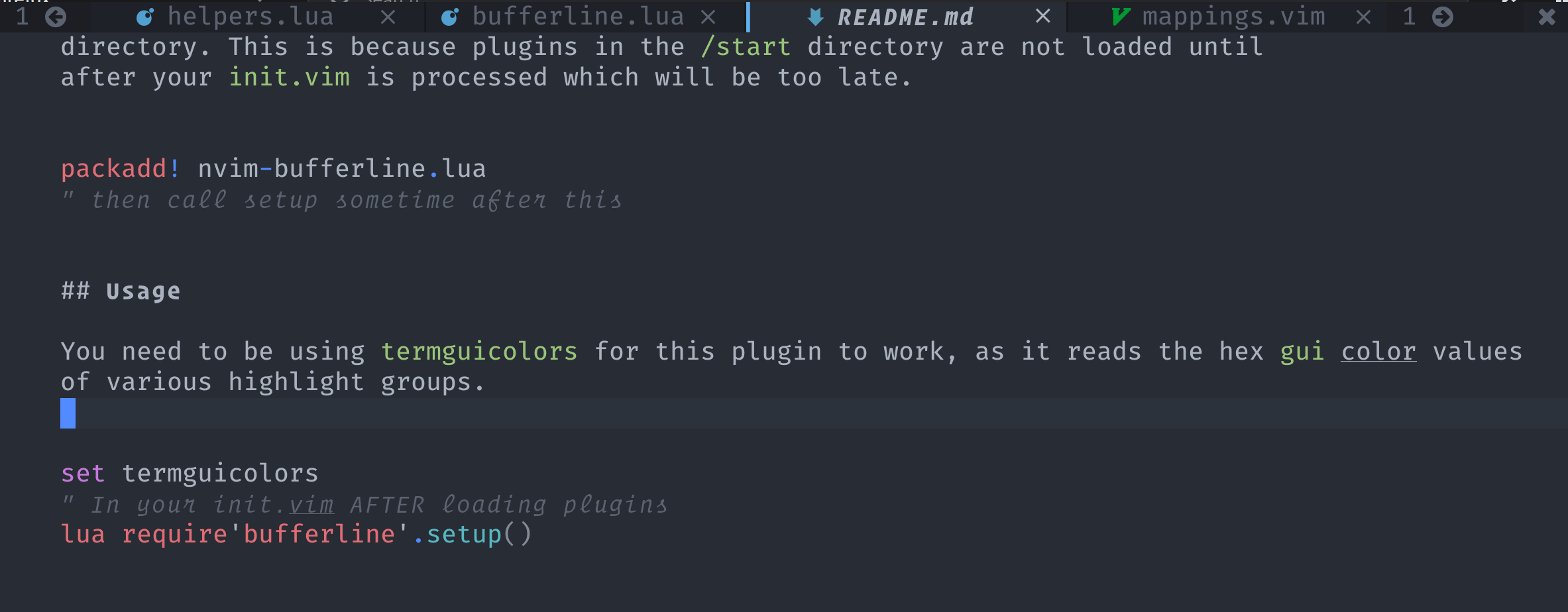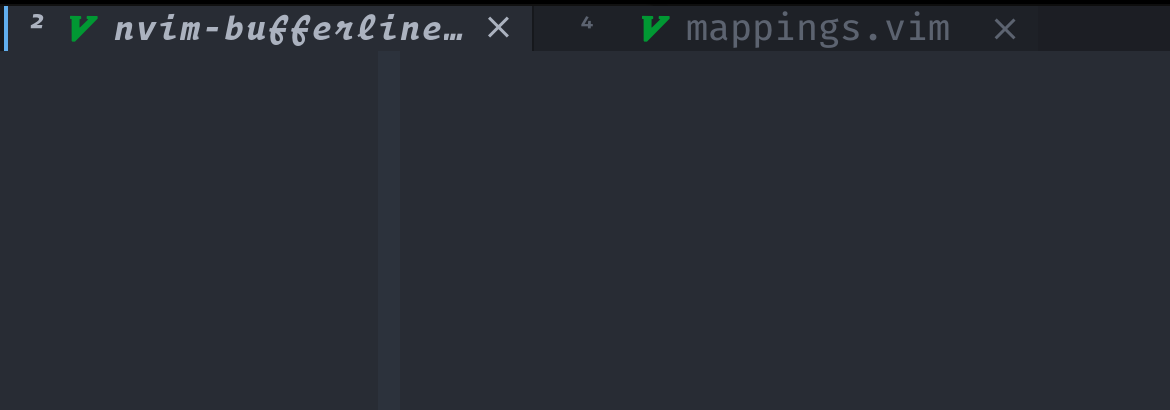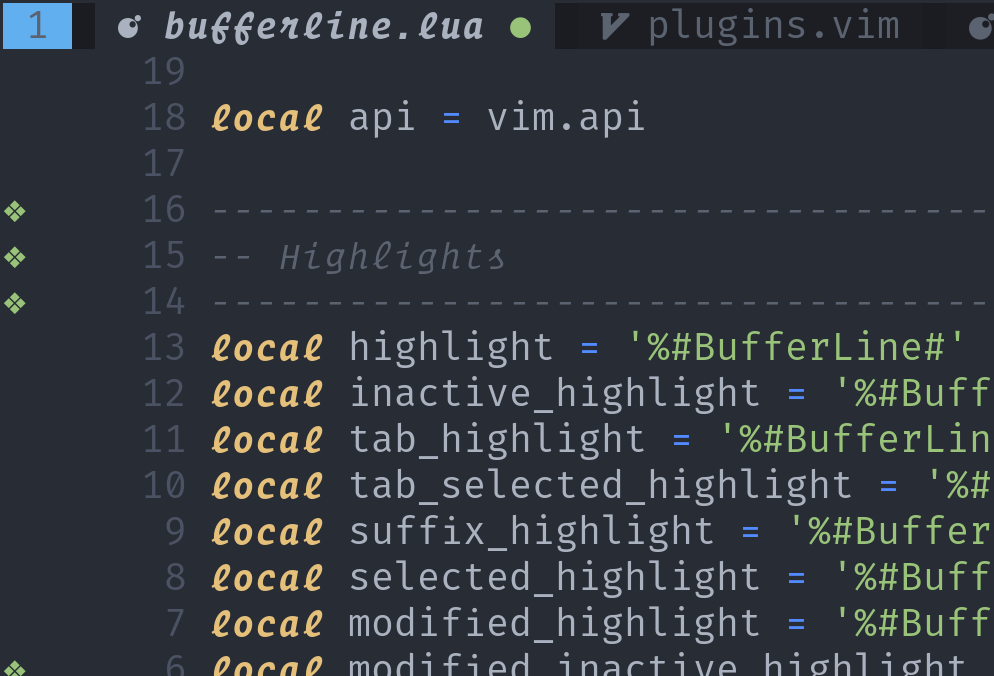A snazzy 💅 buffer line (with minimal tab integration) for Neovim built using lua.
This plugin shamelessly attempts to emulate the aesthetics of GUI text editors/Doom Emacs. It was inspired by a screenshot of DOOM Emacs using centaur tabs. I don't intend to copy all of it's functionality though.
-
Colours derived from colorscheme where possible, should appear similar in most cases
-
Sort buffers by
extension,directoryor pass in a custom compare function
This order can be persisted between sessions (enabled by default).
- Nightly nvim
- A patched font (see nerd fonts)
Super early days there might be some breaking changes, if you use this without configuring it this shouldn't affect you too much.
Plug 'kyazdani42/nvim-web-devicons' " Recommended (for coloured icons)
" Plug 'ryanoasis/vim-devicons' Icons without colours
Plug 'akinsho/nvim-bufferline.lua'If using native packages make sure to add this plugins in the /pack/*/opt
directory. This is because plugins in the /start directory are not loaded until
after your init.vim is processed which will be too late.
packadd! nvim-bufferline.lua
" then call setup sometime after thisYou need to be using termguicolors for this plugin to work, as it reads the hex gui color values
of various highlight groups.
set termguicolors
" In your init.vim AFTER loading plugins
lua require'bufferline'.setup()You can close buffers by clicking the close icon or by right clicking the tab anywhere
A few of this plugins commands can be mapped for ease of use.
" These commands will navigate through buffers in order regardless of which mode you are using
" e.g. if you change the order of buffers :bnext and :bprevious will not respect the custom ordering
nnoremap <silent>[b :BufferLineCycleNext<CR>
nnoremap <silent>b] :BufferLineCyclePrev<CR>
" These commands will move the current buffer backwards or forwards in the bufferline
nnoremap <silent><mymap> :BufferLineMoveNext<CR>
nnoremap <silent><mymap> :BufferLineMovePrev<CR>If you manually arrange your buffers using :BufferLineMove{Prev/Next} during an nvim session this can be persisted for the session.
This is enabled by default but you need to ensure that your sessionopts+=globals otherwise the session file will
not track global variables which is the mechanism used to store your sort order.
This plugin relies on some basic highlights being set by your colour scheme
i.e. Normal, String, TabLineSel (WildMenu as fallback), Comment.
It's unlikely to work with all colour schemes, which is not something I will fix tbh.
You can either try manually overriding the colours or manually creating these highlight groups
before loading this plugin.
If the contrast in your colour scheme is too high, think an all black colour scheme, this plugin won't create a nice tabline.
- I was looking for an excuse to play with lua and learn to create a plugin with it for Neovim.
- I wanted to add some tweaks to my buffer line and didn't want to figure out a bunch of
vimscriptin some other plugin.
🤷 figured someone else might like the aesthetic. Don't make me regret this...
- Make it snazzy
- Maintain general appearance across various colour schemes
- Show only the buffers relevant/open in a specific tab as a configurable setting
- Show LSP diagnostics in bufferline so it's clear which buffers have errors
- Appeal to every single person's tastes. This plugin is opinionated about how the tabline looks, it's unlikely to please everyone, I don't want to try and support a bunch of different appearances.
- Supporting vim please don't ask. The whole point was to create a lua plugin. If vim ends up supporting lua in the same way then maybe.
- Add every possible feature under the sun ☀, to appease everybody.
- Create and maintain a monolith 😓.
- Write nvim help docs
require'bufferline'.setup{
options = {
view = "multiwindow" | "default",
numbers = "none" | "ordinal" | "buffer_id",
number_style = "superscript" | "",
mappings = true | false,
buffer_close_icon= '',
modified_icon = '●',
close_icon = '',
left_trunc_marker = '',
right_trunc_marker = '',
max_name_length = 18,
max_prefix_length = 15, -- prefix used when a buffer is deduplicated
tab_size = 18,
show_buffer_close_icons = true | false,
persist_buffer_sort = true, -- whether or not custom sorted buffers should persist
-- can also be a table containing 2 custom separators
-- [focused and unfocused]. eg: { '|', '|' }
separator_style = "slant" | "thick" | "thin" | { 'any', 'any' },
enforce_regular_tabs = false | true,
always_show_bufferline = true | false,
sort_by = 'extension' | 'relative_directory' | 'directory' | function(buffer_a, buffer_b)
-- add custom logic
return buffer_a.modified > buffer_b.modified
end
}
}If using a plugin such as vim-rooter and you want to sort by path, prefer using directory rather than
relative_directory. Relative directory works by ordering relative paths first, however if you move from
project to project and vim switches its directory, the bufferline will re-order itself as a different set of
buffers will now be relative.
Generally this plugin enforces a minimum tab size so that the buffer line
appears consistent. Where a tab is smaller than the tab size it is padded.
If it is larger than the tab size it is allowed to grow up to the max name
length specified (+ the other indicators).
If you set enforce_regular_tabs = true tabs will be prevented from extending beyond
the tab size and all tabs will be the same length
Bufferline allows you to sort the visible buffers by extension or directory, or for more
advanced usage you can provide a custom compare function which will receive two buffers to compare.
You can see what fields are available to use using
sort_by = function(buffer_a, buffer_b)
print(vim.inspect(buffer_a))
-- add custom logic
return buffer_a.modified > buffer_b.modified
endWhen using a sorted bufferline it's advisable that you use the BufferLineCycleNext and BufferLineCyclePrev
commands since these will traverse the bufferline bufferlist in order whereas bnext and bprev will cycle
buffers according to the buffer numbers given by vim.
Bufferline Pick functionality (inspired by barbar.nvim)
Using the BufferLinePick command will allow for easy selection of a buffer in view.
Trigger the command, using :BufferLinePick or better still map this to a key, e.g.
nnoremap <silent> gb :BufferLinePick<CR>then pick a buffer by typing the character for that specific buffer that appears
Multi-window mode (inspired by vem-tabline)
When this mode is active, for layouts of multiple windows in the tabpage, only the buffers that are displayed in those windows are listed in the tabline. That only applies to multi-window layouts, if there is only one window in the tabpage, all buffers are listed.
If the mappings option is set to true. <leader>1-9 mappings will
be created to navigate the first to the tenth buffer in the bufferline.
This is false by default. If you'd rather map these yourself, use:
nnoremap mymap :lua require"bufferline".go_to_buffer(num)<CR>This plugin is designed to work automatically, deriving colours from the user's theme, but if you must...
Keep in mind that despite my best efforts not to change these they might require the occasional tweak (if you don't customise these too much you should be fine 🤞). If you do, you might need to tweak these occasionally, the plugin will emit a warning if any of the groups you specify don't exist
lua require'bufferline'.setup{
highlights = {
fill = {
guifg = comment_fg,
guibg = separator_background_color
},
background = {
guifg = comment_fg,
guibg = background_color
},
tab = {
guifg = comment_fg,
guibg = background_color
},
tab_selected = {
guifg = tabline_sel_bg,
guibg = normal_bg
},
tab_close = {
guifg = comment_fg,
guibg = background_color
},
buffer_visible = {
guifg = comment_fg,
guibg = visible_bg
},
buffer_selected = {
guifg = normal_fg,
guibg = normal_bg,
gui = "bold,italic"
},
modified = {
guifg = string_fg,
guibg = background_color
},
modified_visible = {
guifg = string_fg,
guibg = visible_bg
},
modified_selected = {
guifg = string_fg,
guibg = normal_bg
},
duplicate_selected = {
guifg = duplicate_color,
gui = "italic",
guibg = normal_bg
},
duplicate_visible = {
guifg = duplicate_color,
gui = "italic",
guibg = visible_bg
},
duplicate = {
guifg = duplicate_color,
gui = "italic",
guibg = background_color
},
separator_selected = {
guifg = separator_background_color,
guibg = normal_bg
},
separator_visible = {
guifg = separator_background_color,
guibg = visible_bg
},
separator = {
guifg = separator_background_color,
guibg = background_color
},
indicator_selected = {
guifg = tabline_sel_bg,
guibg = normal_bg
},
pick_selected = {
guifg = error_fg,
guibg = normal_bg,
gui = "bold,italic"
},
pick_visible = {
guifg = error_fg,
guibg = visible_bg,
gui = "bold,italic"
},
pick = {
guifg = error_fg,
guibg = background_color,
gui = "bold,italic"
}
};
}






